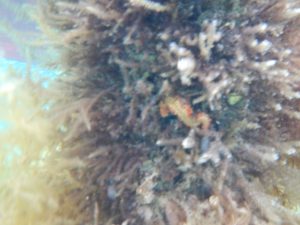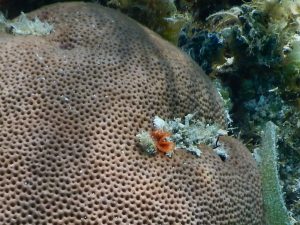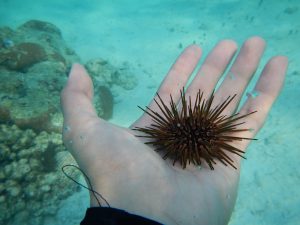Hi friends,
Today was so much better, and yes, I have indeed survived!
We started the day with a lesson on field sampling, and we were taught how to use the quadrat that we made the night before, together with a transect, to get rudimentary field data. It was a nice touch the way we were taught, where we started with a case study on land, before moving to a case study in the nearby seagrass, and finally to a patch reef area which we have to take a boat to. From each case study, we reflected on the problems that popped up, and constantly refined our technique to make the case study more focused each time, and also make the data collection method more accurate. This is how engineers design our systems too! Using iterations of testing and refinement to finally reach a satisfactory end product.
From chasing down hermit crabs in the morning, I moved to avoiding interesting looking inverted green jellyfish right before lunch. I certainly preferred the latter as at least I got to finally see organisms in my taxon! And I definitely felt myself getting better at snorkeling and in general being more comfortable in the aquatic environment. Below are pictures of organisms from my taxon group that I saw in the seagrass:


I was particularly excited to see the bearded fireworm (Hermodice carunculata) as I was expecting it to be swimming around among corals, and not sticking itself to the side of the dock! It looked really gorgeous though I’m well aware of its danger. Actually “though” shouldn’t be the right word to use here as those two things do come together frequently.
After the seagrass experience, we had lunch, and got ready for the second dive. We decided to study the distribution of corals in patch reefs, and counted the amount of live stony corals, dead stony corals, soft corals, sponges, and sand areas in each quadrat sample. Adrienne convinced us to separate the corals into two groups and also to identify sponges though it clearly wasn’t part of the study. Little did we know… it was all part of the grand scheme of things which will be revealed later!
Anyway, after doing the study, I saw more creatures that are part of my taxon groups! Here are some pictures for my eager fans:


Yes, that is what you think it is. It is the beautiful Christmas tree worm!!! The one that I wanted to see so much. It actually took a while for us to become friends and it retracted into the coral that it was perched on when I went in for a closer look, and took its own sweet time to come back out to say hi.
With that, I’ve seen 3 of the 9 species of annelids found in Glover’s reef. I’m gonna find them all!
After that, we went sea urchin catching. It felt like hide and seek except when you find and catch the hiding ones, they prick you. Not that painfully though, and I managed to catch 4 of these little pin cushions. Proof that I actually caught one of them is below:

After dinner, we had a guest lecturer called Dr. Alex Tewfik who talked to us about his work in Glover’s Reef. He talked about the importance of sponges in the coral ecosystem and how they may have been overlooked in the past and may actually be the key to completing the food web in this ecosystem. Adrienne then referenced the earlier case study when we were only going to count corals but were suggested to count sponges too, and how these additional data often can turn out to be useful. That was cool how she tied it back to what we learned in the day!
Oh by the way, as I am sitting down typing this right now, I feel like I am still on the boat, as I feel the drifting sensation in my mind even as I am sitting down here. Kind of disorientating, but kind of interesting too! And it’s been a long day, so I shall end here for now.
Till next time,
Damien the slightly-improved snorkeler
